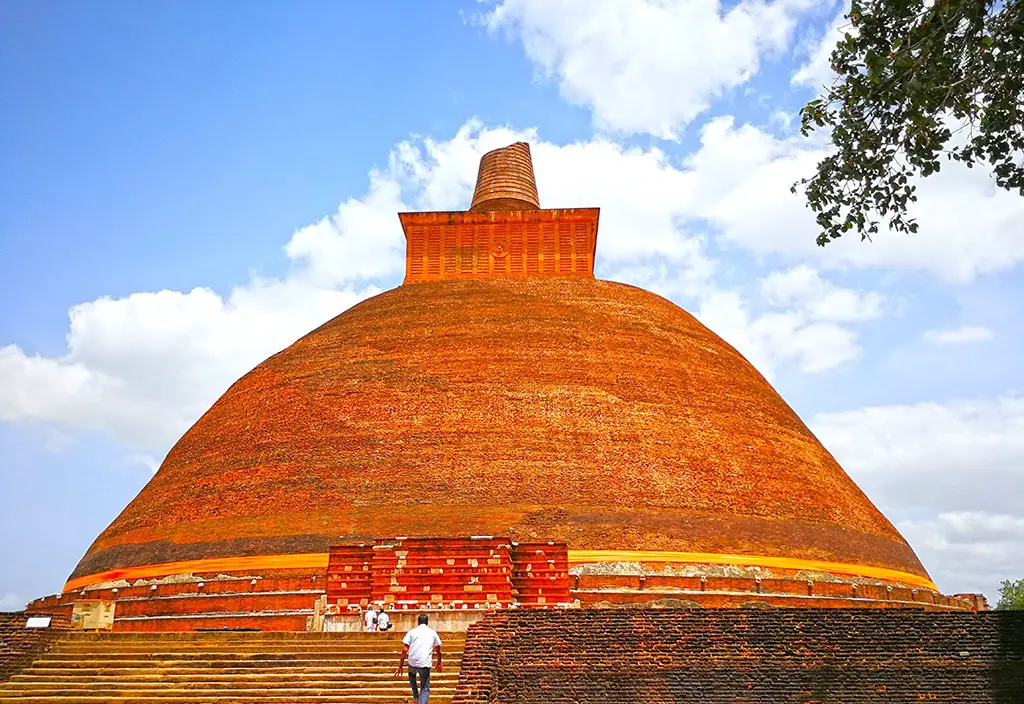Sources such as the Mahavamsa and the Nikaya Sangraha state that King Mahasen followed the advice of a sinful Mahayana monk named Sangamithra.The end result was that the king accepted the Abhayagiri view. Therefore, the monks of the Maha Vihara became angry with the king. Using state power, the Maha Vihara was banned. Donations were prohibited. As a result, the Maha Vihara was empty of monks for nine months. At no time was the temple so badly damaged. When the Maha Vihara was in trouble, the Abhayagiri Vihara was awarded the royal title.
Nine months later, a minister named Meghawarna fought against the king’s treacherous actions, which were later settled through negotiations, and the king immediately brought back the Maha Vihara monks. Even after this, King Mahasen made the Jetavanaramaya in the Jethawana Park beyond the boundaries of the Maha Vihara. Its main building was the Jetavana Stupa, the largest stupa in Sri Lanka and in the world. The construction of the Jethawana Vihara with the Dagaba here within the boundaries of the Maha Vihara caused another confusion. Despite the opposition of the Maha Vihara monks to this arbitrary act of the King, the King did not accept the objections and handed over the Jetavana Vihara to a Bhikkhu named Tissa. Undaunted, the Maha Vihara monks complained to the court, accusing the Tissa monk of accepting the Jetavana as the last resort. The Minister of Justice who examined this struggle changed the robes of Tissa Thero despite the King’s reluctance.
The Jethavanaramaya, which was built in the midst of such a great debate, is a sacred place of religious as well as political significance in the history of Ceylon. The main reason for its sacredness is that it is treasured on the “Pati da”. As mentioned earlier, this monastery is called Jothiwana or Jethawana as it was built in Jothiwana or Jethawana and is sometimes referred to as Dena Vehera. The Jetavanaramaya in Savathnuwara is better known as Devram Vehera. The sect that originated from Jetavana is also known as the “Dena sect”.
Mr Emerson Tennant says that the bricks used to build the Jetavanaramaya could be used to build a 10-foot-high wall from London to Edinburgh. The Dagaba is about 400 feet high and 367 feet in diameter. Although the foundation is made of gravel from 20 feet below, it has been found that the entire stupa is made of bricks. The 8-acre courtyard of the Jethawana Stupa, which also has a gateway and an ivory wall, has been paved by devotees from time to time. The names of the donors are engraved on the stones. Mr Walisinghe Harischandra says that the forest of the Dagaba, which was completely forested, was cleared around 1828 and a part of the fort was demolished in 1882 and restored by the British government. Part of the Tower Rebellion was also made during this renovation. In 1887, the government deceived the Buddhists into believing that it was the Abhayagiriya and that it contained the Tripitaka of King Walagamba’s day, and dug a pit 33 feet above the ground. They dug 162 feet deep but could not find the treasure they needed. An anti-Buddhist movement arose and it was abandoned and re-enlisted.
The Jethawana Dagaba had been destroyed by weeds, but only a small part of it was found. They have now been redesigned. There is a very old form in the carvings on the pillars. The conservation work of the stupa, which had been done for many years, was completed in 2012.















